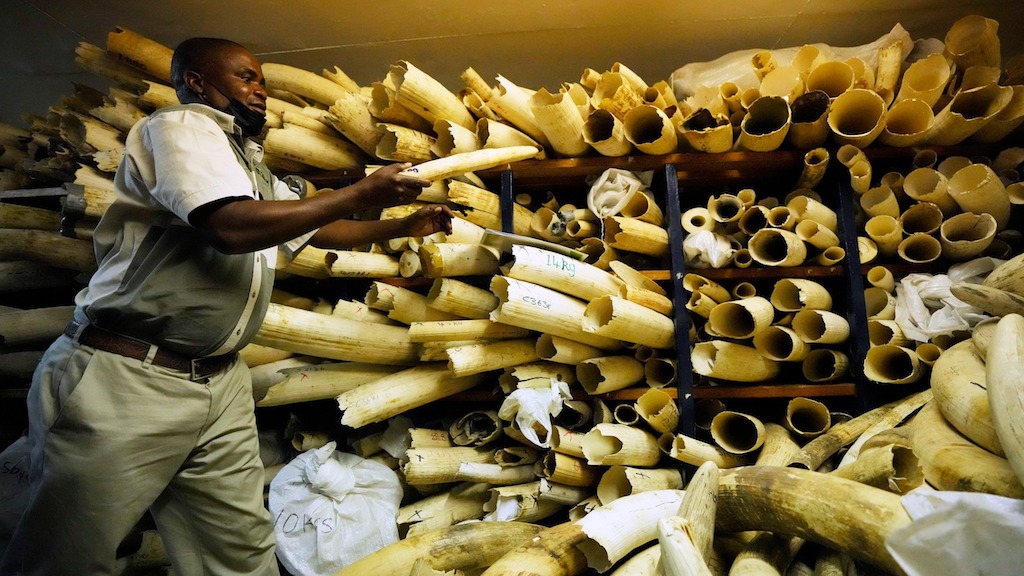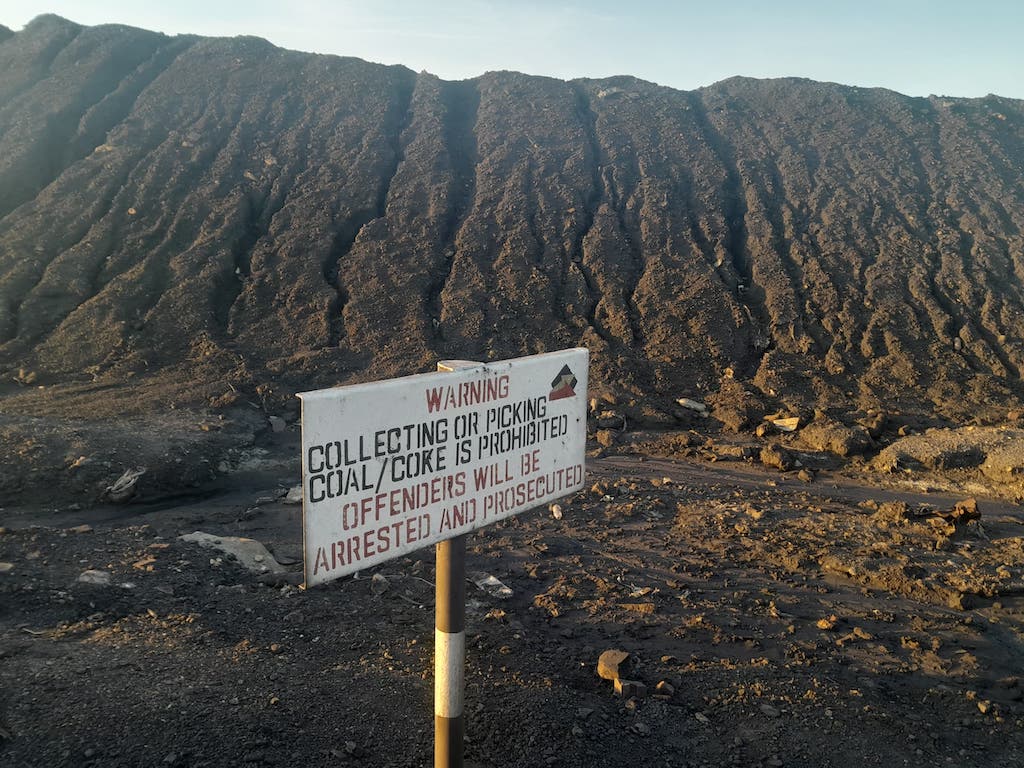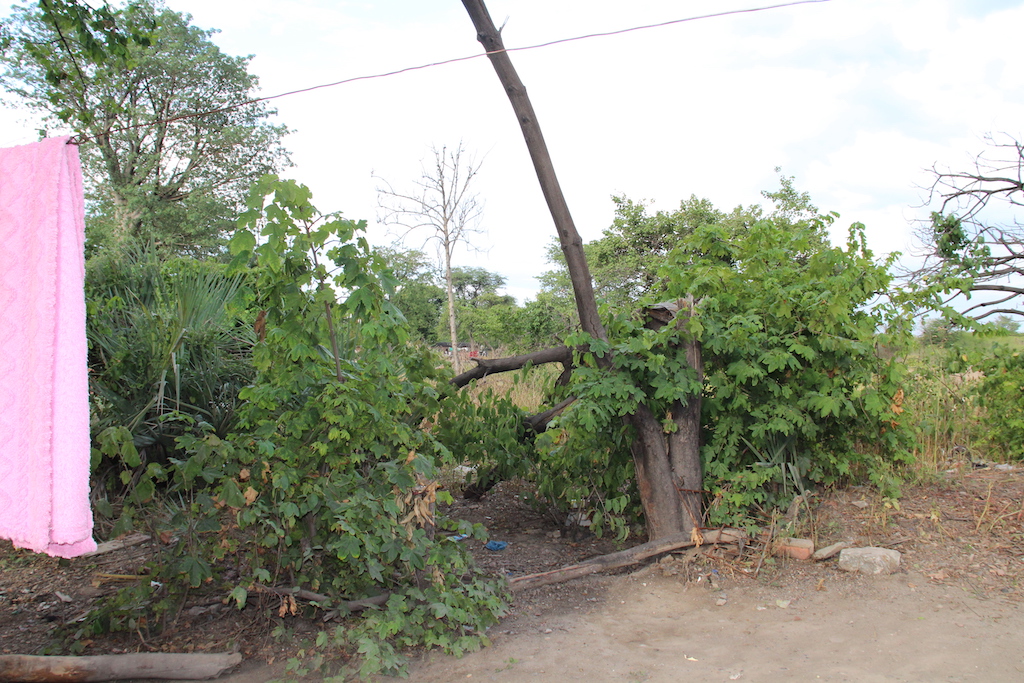
04 Jun Silent extinction: Zimbabwe’s hotbed of environmental crime
Poaching and illegal coal mining threaten the future of Matabeleland’s elephant population. Nokuthaba Mathema investigates

Ivory stockpile: The elephant herds of Matabeleland are primary targets of ‘sponsored poaching’ with the collusion of state officials, says one expert. Photo: AP/Tsvangirayi Mukwazhi
In the shadows of Zimbabwe’s environmental management lies a devastating truth: environmental crimes, such as poaching, illegal wildlife trade and illicit coal mining continue to afflict Zimbabwe’s Matabeleland province in the south-west of the country.
In May this year, a tip-off by locals ended in one death, two arrests and the discovery of endangered animal parts. Detectives from the Crime Investigation Department confronted three alleged poachers on the outskirts of the capital city, Bulawayo, on May 18 – Jabulani Chamiti (34), Philani Ndlovu (23) and Cosmas Sebele (56).
They shot and killed Chamiti after he tried to run over one of the law enforcement agents in the trio’s getaway car, and arrested Ndlovu and Sebele. They were charged with illegal possession of five pieces of elephant tusk and a pangolin skin, and are set to appear in court soon.
Less than 20km away, disused and uncovered mines belonging to Hwange Colliery have become hotspots for illegal mining. Not only do they wreak havoc on land and livelihoods, but also pose a significant threat to the natural habitats of elephants.
These stories shine a spotlight on the urgent need for increased vigilance and stronger regulations to protect Zimbabwe’s natural heritage, experts say.
‘Sponsored’ poaching
Data from court records indicate Zimbabwe has made significant progress in combating wildlife crimes over the past year. In 2023 courts around the country heard more than 1,300 cases related to wildlife crimes. The majority was based in Mashonaland West, Masvingo and Matabeleland North, where some of the country’s biggest national parks and game reserves are based, including Hwange National Park.
The Harare Magistrate’s Court has dedicated Court 5 to deal with environmental crimes. Official statistics released by the National Prosecuting Authority in April showed the Harare metropolitan province addressed 34 cases related to wildlife crimes in the first quarter of 2024.
However, a local wildlife expert who asked to remain anonymous for safety reasons, said cases of poaching in Zimbabwe remain underreported.
Due to international opposition against the culling of elephants by African range countries, incidents of what is known as “sponsored poaching” involving the collusion of state officials are on the rise, she said.
“This perverse dynamic leads to a situation where it is deemed acceptable to ‘take care’ of the elephants by killing them – a practice equivalent to poaching, yet unnoticed and unreported,” she said.
The elephant herds in Matabeleland are “primary targets, for the sake of ivory”, according to her. In Matabeleland North the Hwange National Park, the country’s largest natural reserve spanning 14,600 square kilometres, is home to more than 45,000 savanna elephants.
The law on poaching in Zimbabwe is primarily governed by the Parks and Wildlife Act, which prohibits the unauthorised hunting, killing or capture of protected wildlife species. It designates protected areas, regulates licensing and permits for legal hunting and imposes penalties for poaching offences.
Wildlife conservationist Deborah Ottman, from the Kariba Animal Welfare Fund Trust, poked holes in the justice system: “The judiciary is not doing enough to curb it [poaching] regarding their sentences or community service.”

Crime nexus: Prisca Dube of Zimbabwe Lawyers for Human Rights suggested a possible link between wildlife rangers and the criminal networks driving the illegal poaching trade. Photo courtesy Zimbabwe Lawyers for Human Rights
‘Minimum force’
As authorities grapple with poaching, incidents involving the use of “minimum force” by the police have sparked emotional debates, leaving conservationists and wildlife enthusiasts questioning the integrity of those entrusted with preserving wildlife.
Prisca Dube of Zimbabwe Lawyers for Human Rights suggested a possible “nexus between park rangers responsible for safeguarding wildlife and the criminal networks driving the illegal poaching trade”.
“Maybe rangers collude with poachers and when police come in, it is with ‘minimum force’,” she said,
In December last year, a Zimbabwe Parks and Wildlife Management Authority (ZimParks) ranger, Noel Zuze, was nabbed with 80kg of ivory in Chinhoyi in central northern Zimbabwe.
In April 2022 a Hwange National Park ranger, Simibio Kakomo (38), and police officer Shepherd Musiniwa (31) were arrested with more than 28kg of elephant tusks and charged with unlawful possession.

Ecological challenge: Illegal coal mining directly affects the elephants of Hwange National Park, as it encroaches on their habitat and threatens their food sources. Photo: Nokuthaba Mathema
Illegal mining
Illegal mining operations also pose a threat to the natural habitats of these species. As individuals driven by desperation engage in unauthorised mining, the encroachment on elephant territories exacerbates the ecological challenges the animals face.
The destruction of vegetation, pollution of water sources and disruption of ecological balance caused by illegal mining disrupts the natural ecosystem and jeopardises the survival of not only elephants but also other wildlife species.
Peter Phiri, a resident from a village near Hwange National Park, described these activities as “perilous, with reports of mine collapses” resulting in death and people becoming trapped. “These mines remain open and neglected, devoid of proper maintenance or security measures,” he said.
He described how residents of the village have seen a significant decline in wildlife due to noise and air pollution from the illegal mining activities.
Another major issue is the use of cyanide in poaching. The poison is used in the country’s mining industry and its distribution is supposed to be tightly restricted.
Five years after the 2013 mass poisoning of more than 135 elephants in Hwange National Park, Zimbabwe made important changes to the Environmental Management Act.
One of those changes meant that prosecutors no longer have to establish that cyanide was actually used in a poaching case, only that there was “intent to poison maliciously”, according to a 2022 study published in the African Journal of Wildlife Research.

Dangerous neighbours: Elephants trample trees and crops in villages bordering Hwange National Park. Photo: Nokuthaba Mathema
Human-wildlife conflict
As human settlements expand and illicit mining activities increase, Hwange’s elephant population is not only facing the threats of poaching and loss of natural resources, they are now being forced into heavily populated areas, putting both them and local residents in danger.
Dube described the resulting human-wildlife conflict as a “serious breach” of environmental rights. She urged the government to address the challenge as a matter of urgency.
“How about revisiting the land system to ensure that communal lands are not adjacent to national parks?” she asked. “This approach aims to reduce human-animal conflicts by strategically separating these areas.
“Additionally, it is important to involve local communities meaningfully in all conservation efforts. By fostering beneficial engagement, we can create win-win situations where communities directly benefit from conserving animals,” Dube said
Peggy Ndlovu, a resident of Village 3 in Hwange, said locals now have to compete with the elephants for food sources in the form of crops, and at the same time fear for their own safety as they regularly come into contact with these large, wild animals.
“In the past, we coexisted peacefully, as elephants roamed freely in the surrounding forests without causing much harm to the community,” Ndlovu said.
Renowned Zimbabwe-based conservationist Sarah Savory reflected on the plight of the country’s elephants by emphasising the need for significant change. “There is no short-term solution until we address the management of the environment, achieving a holistic balance in environmental, social and economic aspects,” she said.

The role of AI
The use of artificial intelligence (AI) in preserving Zimbabwe’s biodiversity and natural landscapes is on the rise.
According to David Cain, a tech expert and senior patent attorney, there is “tremendous potential” when it comes to AI in curbing environmental crimes. “By adopting AI technologies, Zimbabwe stands to significantly enhance the effectiveness in reducing wildlife crime, support sustainable development and strengthen the protection of endangered species,” he said.
With tools that use facial recognition technologies to identify individual animals, particularly those most threatened by poaching, like elephants and rhinos, AI can be used to help monitor species movements and provide evidence for prosecuting wildlife crimes, he said.
In April this year a project by ZimParks and the International Fund for Animal Welfare (IFAW) saw conservationists fitting GPS-enabled tracking collars to eight elephants in the Hwange National Park, to track how constructing a nearby dam might affect their movements.
By collecting and analysing this data, experts are taking the first steps in expanding monitoring to more complex AI tools.
Nokuthaba Mathema is a Zimbabwe-based journalist and alumnus of the Oxpeckers #WildEye training programme titled The Nexus of Data and Environmental Journalism. The programme and this investigation are supported by the Fojo Journalism Education Programme, incorporated under International Media Support and Fojo Media lnstitute’s Media Nexus Programme 2022-2025 in Zimbabwe, funded by Sida
Find the #WildEye tool and more investigations here
